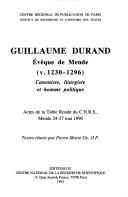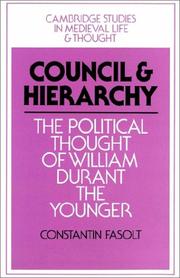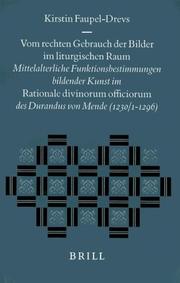| Listing 1 - 10 of 11 | << page >> |
Sort by
|
Book
ISBN: 9782600014021 2600014020 Year: 2010 Volume: 250 Publisher: Genève Droz
Abstract | Keywords | Export | Availability | Bookmark
 Loading...
Loading...Choose an application
- Reference Manager
- EndNote
- RefWorks (Direct export to RefWorks)
Periodical
ISBN: 9782503555508 Year: 2015 Publisher: Turnhout Brepols
Abstract | Keywords | Export | Availability | Bookmark
 Loading...
Loading...Choose an application
- Reference Manager
- EndNote
- RefWorks (Direct export to RefWorks)
Durand, Guillaume --- Translations into English --- Catholic Church --- Liturgy --- Early works to 1800 --- Divine office --- Early works to 1800
Book
Year: 1983 Publisher: Assen Van Gorcum
Abstract | Keywords | Export | Availability | Bookmark
 Loading...
Loading...Choose an application
- Reference Manager
- EndNote
- RefWorks (Direct export to RefWorks)
Book
ISBN: 9782503555508 2503555500 Year: 2015 Volume: 23 140 5 Publisher: Turnhout Brepols
Abstract | Keywords | Export | Availability | Bookmark
 Loading...
Loading...Choose an application
- Reference Manager
- EndNote
- RefWorks (Direct export to RefWorks)
"William Durand (c. 1230-Nov. 1, 1296), Bishop of Mende, France, was unquestionably the most renowned liturgical scholar of the later Middle Ages. His encyclopedic allegorical exposition of the rites and worship services of the Latin Church, the Rationale divinorum officiorum, or "Rationale for the divine offices," is the best known medieval work in its genre. Divided into eight books of varying length, the Rationale is exhaustive in its treatment of a wide variety of subjects: the church building and liturgical art; the ministers of the church and their functions; liturgical vestments; the Mass and the Divine Office; the Church's calendar and its feast days. Modern scholarship has clearly shown that Durand's Rationale superseded all previous liturgical commentaries within only a few years of its publication (c. 1292-1296). By the end of the fifteenth century, it had become one of the most widely disseminated treatises of its kind in western Europe."--Publisher description.
Durand, Guillaume --- Translations into English --- Catholic Church --- Liturgy --- Early works to 1800 --- Divine office --- 2 DURANDUS, GUILELMUS --- 2 DURANDUS, GUILELMUS Godsdienst. Theologie--DURANDUS, GUILELMUS --- Godsdienst. Theologie--DURANDUS, GUILELMUS --- Daily offices --- Liturgy of the hours --- Office, Divine --- Prayer --- Christianity --- Durand, Guillaume, --- Divine office. --- Liturgics. --- Catholic Church. --- Rationale divinorum officiorum (Durand, Guillaume). --- Office divin --- Early works to 1800. --- Ouvrages avant 1800 --- Church of Rome --- Roman Catholic Church --- Katholische Kirche --- Katolyt︠s︡ʹka t︠s︡erkva --- Römisch-Katholische Kirche --- Römische Kirche --- Ecclesia Catholica --- Eglise catholique --- Eglise catholique-romaine --- Katolicheskai︠a︡ t︠s︡erkovʹ --- Chiesa cattolica --- Iglesia Católica --- Kościół Katolicki --- Katolicki Kościół --- Kościół Rzymskokatolicki --- Nihon Katorikku Kyōkai --- Katholikē Ekklēsia --- Gereja Katolik --- Kenesiyah ha-Ḳatolit --- Kanisa Katoliki --- כנסיה הקתולית --- כנסייה הקתולית --- 가톨릭교 --- 천주교
Book

ISBN: 9782503524214 2503524214 9782503538419 Year: 2006 Volume: 6 Publisher: Turnhout Brepols
Abstract | Keywords | Export | Availability | Bookmark
 Loading...
Loading...Choose an application
- Reference Manager
- EndNote
- RefWorks (Direct export to RefWorks)
Chaque année, depuis l’an 2000, un colloque pluridisciplinaire organisé par Rencontres Médiévales européennes permet l’approfondissement des études sur l’art et la liturgie au Moyen-Âge, principalement aux xiie et xiiie siècles. Ce sont les différentes composantes de la pensée religieuse qui sont ainsi cernées et qui se révèlent être une part importante de l’originalité de la civilisation européenne. Ce n’est pas une culture morte qui est exhumée mais bel et bien les points de repère qui font cruellement défaut à la société actuelle.L’image pour l’image est un produit du xxie siècle. Le tourbillon de représentations visuelles qui matraquent certains individus à toute heure, en tous lieux, avec des conséquences dramatiques parfois, est l’apanage malheureux de notre époque. Nos ancêtres, eux, se donnaient le temps de réfléchir à ce que signifiait ce à quoi ils allaient donner forme. C’est pourquoi l’image religieuse médiévale nous frappe autant, non seulement par son côté esthétique, mais parce qu’elle est lourde de spiritualité et de sens. Les hommes avaient ainsi conscience d’appartenir à une même société car ils savaient que, derrière chaque image, l’histoire racontée était la leur.
Christian church history --- Iconography --- anno 1200-1299 --- anno 1100-1199 --- Art, Medieval --- Christian art and symbolism --- middeleeuwen --- religies --- filosofie --- muziek --- iconografie --- Durand, Guillaume --- 12de eeuw --- 13de eeuw --- 14de eeuw --- Image (Philosophy) --- Image (Philosophie) --- Art médiéval --- Congresses --- Congrès --- Art --- History --- Middle Ages --- Religious thought --- Middle Ages, 600-1500 --- Middle Ages, 500-1500 --- middeleeuwen, middeleeuwse geschiedenis (historisch tijdvak) --- Art, Medieval - Congresses. --- Christian art and symbolism - Congresses. --- middeleeuwen, middeleeuwse geschiedenis (historisch tijdvak). --- religies. --- filosofie. --- muziek. --- iconografie. --- Durand, Guillaume. --- 12de eeuw. --- 13de eeuw. --- 14de eeuw. --- Art medieval --- Art chretien --- Congres --- Moyen age

ISBN: 222204667X 9782222046677 Year: 1992 Publisher: Paris Centre National de la Recherche Scientifique
Abstract | Keywords | Export | Availability | Bookmark
 Loading...
Loading...Choose an application
- Reference Manager
- EndNote
- RefWorks (Direct export to RefWorks)
Canon law --- Droit canonique --- Interpretation and construction --- Congresses --- Interprétation --- Congrès --- Durand, Guillaume, --- Views on Liturgics --- Views on Canon Law --- Catholic Church --- Catholic church --- Eglise catholique --- Bishops --- Biography --- Liturgy --- Evêques --- Biographie --- Liturgie --- History --- Histoire --- Interprétation --- Congrès --- Evêques --- Congresses. --- History.

ISBN: 0521392853 0521894085 0511523165 Year: 1991 Publisher: Cambridge : Cambridge University Press,
Abstract | Keywords | Export | Availability | Bookmark
 Loading...
Loading...Choose an application
- Reference Manager
- EndNote
- RefWorks (Direct export to RefWorks)
In 1311, at the council of Vienne, William Durant the Younger (c. 1266-1330), the French bishop and count, demanded that general councils ought to meet every ten years in order to place effective limits on the papal plenitude of power because 'what touches all must be approved by all'. This is the first systematic interpretation of William Durant's remarkable project to transfer supreme legislative authority from the papacy to general councils. It suggests that the conciliar theory has a more ambivalent complexion than is sometimes recognized. It confirms, on the one hand, that constitutional ideas were deeply embedded in the tradition of the church, which enabled Durant to anticipate the council of Constance by more than a hundred years. On the other hand, Durant attributed an authority to ancient law that overrode his republican ideas, sapped their vitality, and launched him on a pursuit of the true meaning of the law that could end only in his transformation into an historian and a reluctant champion of monarchy. William Durant the Younger's ideas thus help us to understand both the origins of the conciliar theory and the transition from late medieval reform movements to early modern humanism and princely sovereignty.
Church and state --- -Popes --- -Holy See --- See, Holy --- Papacy --- Christianity and state --- Separation of church and state --- State and church --- State, The --- History --- Temporal power --- Duranti, William --- -Contributions in political science --- -History --- Popes --- Church history --- Temporal power of religious rulers --- Roman question --- Duranti, William, --- Durand, Guillaume, --- Durandus, Guillelmus, --- Durandus, Wilhelm, --- Durandus, William, --- Durant, William, --- Political and social views. --- Arts and Humanities --- History. --- Temporal power.

ISBN: 9004113150 9004476474 Year: 2000 Volume: 89 Publisher: Leiden ; Boston ; Köln Brill
Abstract | Keywords | Export | Availability | Bookmark
 Loading...
Loading...Choose an application
- Reference Manager
- EndNote
- RefWorks (Direct export to RefWorks)
Liturgy --- Iconography --- Durandus, Guilielmus [sr.] --- Art [Christian ] --- Art [Eclesiastical ] --- Art chrétien --- Art ecclésiastique --- Art et symbolisme chrétiens --- Art religieux chrétien --- Art sacré --- Arts in the Church --- Christelijke iconografie --- Christelijke kunst en symboliek --- Christelijke symboliek --- Christian art and symbolism --- Christian symbolism --- Ecclesiastical art --- Godsdienstige kunst [Christelijke ] --- Iconografie [Christelijke ] --- Iconographie chrétienne --- Kerkelijke kunst --- Kunst [Christelijke ] --- Kunst [Godsdienstige ] [Christelijke ] --- Kunst [Kerkelijke ] --- Kunst [Sacrale ] --- Liturgics --- Liturgies et science de la liturgie --- Liturgieën en liturgiewetenschap --- Religious art [Christian ] --- Sacrale kunst --- Sacred art --- Symboliek [Christelijke ] --- Symbolisme chrétien --- Christian art and symbolism. --- Liturgics. --- Liturgie --- Durand, Guillaume, --- 246.3 --- Liturgiology --- Public worship --- Liturgies --- Art, Christian --- Art, Ecclesiastical --- Arts in the church --- Religious art, Christian --- Symbolism and Christian art --- Art --- Symbolism --- Christian antiquities --- Church decoration and ornament --- Beelden in kerken. Beeldenverering. Iconoclasme --- Durantis, Guilelmus --- 246.3 Beelden in kerken. Beeldenverering. Iconoclasme --- Guillelmus Durantus --- Durandus, Guillelmus --- Durand, Guillaume --- Durandus Mimatensis --- Durantis, Wilhelm --- Durandus, Wilhelm --- Art et symbolisme chrétiens --- Duranti, Guilelmus --- Religious art --- Symbolism in art
Book
ISBN: 9783402112670 3402112671 Year: 2016 Volume: 107/1-3 Publisher: Münster Aschendorff Verlag GmbH
Abstract | Keywords | Export | Availability | Bookmark
 Loading...
Loading...Choose an application
- Reference Manager
- EndNote
- RefWorks (Direct export to RefWorks)
2 DURANDUS, GUILELMUS --- 2 DURANDUS, GUILELMUS Godsdienst. Theologie--DURANDUS, GUILELMUS --- Godsdienst. Theologie--DURANDUS, GUILELMUS --- Durand, Guillaume, --- Catholic Church --- Liturgy --- Church of Rome --- Roman Catholic Church --- Katholische Kirche --- Katolyt︠s︡ʹka t︠s︡erkva --- Römisch-Katholische Kirche --- Römische Kirche --- Ecclesia Catholica --- Eglise catholique --- Eglise catholique-romaine --- Katolicheskai︠a︡ t︠s︡erkovʹ --- Chiesa cattolica --- Iglesia Católica --- Kościół Katolicki --- Katolicki Kościół --- Kościół Rzymskokatolicki --- Nihon Katorikku Kyōkai --- Katholikē Ekklēsia --- Gereja Katolik --- Kenesiyah ha-Ḳatolit --- Kanisa Katoliki --- כנסיה הקתולית --- כנסייה הקתולית --- 가톨릭교 --- 천주교
Book
ISBN: 9782503548791 2503548792 Year: 2013 Volume: 14 140 4 Publisher: Turnhout Brepols
Abstract | Keywords | Export | Availability | Bookmark
 Loading...
Loading...Choose an application
- Reference Manager
- EndNote
- RefWorks (Direct export to RefWorks)
"William Durand (c. 1230-Nov. 1, 1296), Bishop of Mende, France, was unquestionably the most renowned liturgical scholar of the later Middle Ages. His encyclopedic allegorical exposition of the rites and worship services of the Latin Church, the Rationale divinorum officiorum, or "Rationale for the divine offices," is the best known medieval work in its genre. Divided into eight books of varying length, the Rationale is exhaustive in its treatment of a wide variety of subjects: the church building and liturgical art; the ministers of the church and their functions; liturgical vestments; the Mass and the Divine Office; the Church's calendar and its feast days. Modern scholarship has clearly shown that Durand's Rationale superseded all previous liturgical commentaries within only a few years of its publication (c. 1292-1296). By the end of the fifteenth century, it had become one of the most widely disseminated treatises of its kind in western Europe."--Publisher description.
Architecture religieuse --- Architecture symbolism --- Art [Christian ] --- Art [Eclesiastical ] --- Art chrétien --- Art ecclésiastique --- Art et symbolisme chrétiens --- Art religieux chrétien --- Art sacré --- Arts in the Church --- Christelijke iconografie --- Christelijke kunst en symboliek --- Christelijke symboliek --- Christian art and symbolism --- Christian symbolism --- Ecclesiastical art --- Godsdienstige kunst [Christelijke ] --- Iconografie [Christelijke ] --- Iconographie chrétienne --- Kerkelijke kunst --- Kunst [Christelijke ] --- Kunst [Godsdienstige ] [Christelijke ] --- Kunst [Kerkelijke ] --- Kunst [Sacrale ] --- Religieuze architectuur --- Religious architecture --- Religious art [Christian ] --- Sacrale kunst --- Sacred art --- Spiritual architecture --- Symboliek [Christelijke ] --- Symboliek in de architectuur --- Symbolism in architecture --- Symbolisme chrétien --- Symbolisme dans l'architecture --- Mass --- Messe --- Early works to 1800. --- Ouvrages avant 1800 --- Durand, Guillaume, --- Catholic Church --- Liturgy --- 2 DURANDUS, GUILELMUS --- 2 DURANDUS, GUILELMUS Godsdienst. Theologie--DURANDUS, GUILELMUS --- Godsdienst. Theologie--DURANDUS, GUILELMUS --- Church of Rome --- Roman Catholic Church --- Katholische Kirche --- Katolyt︠s︡ʹka t︠s︡erkva --- Römisch-Katholische Kirche --- Römische Kirche --- Ecclesia Catholica --- Eglise catholique --- Eglise catholique-romaine --- Katolicheskai︠a︡ t︠s︡erkovʹ --- Chiesa cattolica --- Iglesia Católica --- Kościół Katolicki --- Katolicki Kościół --- Kościół Rzymskokatolicki --- Nihon Katorikku Kyōkai --- Katholikē Ekklēsia --- Gereja Katolik --- Kenesiyah ha-Ḳatolit --- Kanisa Katoliki --- כנסיה הקתולית --- כנסייה הקתולית --- 가톨릭교 --- 천주교
| Listing 1 - 10 of 11 | << page >> |
Sort by
|

 Search
Search Feedback
Feedback About
About Help
Help News
News